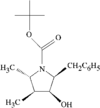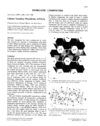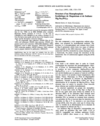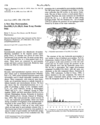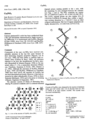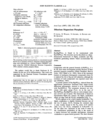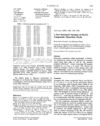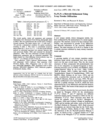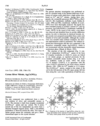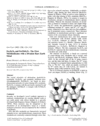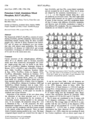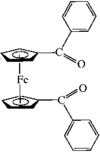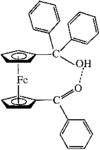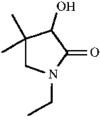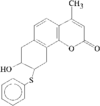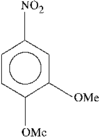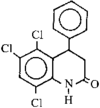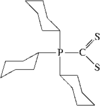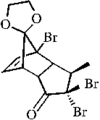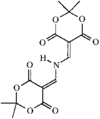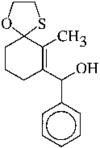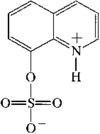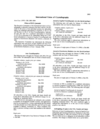issue contents
December 1997 issue

Cover illustration: A New Zinc Pyrovanadate, Zn3(OH)2V2O7.2H2O, from X-ray Powder Data, see Zavalij, Zhang & Whittingham, pages 1738-1739.
cif-access (inorganic compounds)
Download citation


Download citation


cif-access (organic compounds)
Download citation


Download citation


Download citation


Download citation


Download citation


Download citation


Download citation


Download citation


Download citation


Download citation


Download citation


Download citation


inorganic compounds
Download citation


Download citation


The structure of the pyroxene LiVSi2O6 is composed of infinite chains of edge-sharing VO6 octahedra linked together by corner-sharing SiO4 tetrahedra.
Download citation


Download citation


The structure of YBa(Cu1.10Co0.90)O5 is constructed from the four bound layers BaO–(Cu,Co)O2–Y–(Cu,Co)O2. The mixed (Cu,Co) site atoms form distorted square-pyramidal pair-layers based on (Cu,Co)2O9, linked through their basal and apical O atoms.
Download citation


Download citation


The crystal structure of CdLn[B5O10] (Ln = La, Sm, Eu) contains planar infinite two-dimensional [B5O10]5− polyborate anions perpendicular to [101], separated by LnO10 polyhedra and Cd2O10 octahedral dimers. Three out of the five B atoms are four-coordinate, the other two have trigonal planar coordination.
Download citation


Download citation


The structure of the monophosphate Mg3Na3(PO4)3 contains three kinds of Mg–O polyhedra which form two types of infinite chain parallel to the shortest axis of the cell. The chains are connected with PO4 tetrahedra by corner-sharing to form a framework. The 1/3 substructure appears along the longest axis of the cell.
Download citation


Download citation


The mixed compound (Ba1-δSrδ)6Mg7F26 has a structure which can be described as comprising perovskite-like blocks and rutile-related parts. Only one of the two Ba sites is partially (30%) replaced by Sr.
Download citation


Download citation


Rietveld refinement of a new zinc divanadate, Zn3(OH)2V2O7.2H2O, shows that it has a porous framework structure assembled from layers of Zn–O octahedra joined by pyrovanadate groups. Water molecules fill the large cavities.
Download citation


Download citation


The structure of Ca4PtO6 consists of chains of alternating face-sharing Pt-centered octahedra and distorted Ca-centered trigonal prisms running parallel to the c axis, with the remaining Ca2+ ions arranged between the columns.
Download citation


Download citation


Ba2Mg(PO4)2 is isostructural with Ba2Ni(PO4)2 and consists of a three-dimensional framework of MgO6 octahedra and PO4 tetrahedra generating tunnels which accommodate Ba atoms.
Download citation


Download citation


Monoclinic Nb3SI7 crystallizes in a novel two-dimensional structure. The structure comprises [Nb3SI10]3− clusters which contain Nb triangles bicapped by μ3-I and μ3-S atoms. The clusters are linked to form dimeric units and these dimers are cross-linked to form layers of composition Nb3SI7.
Download citation


Download citation


Fe3W3N is isostructural with Westgren's cubic η-carbide structure and contains two sets of coordination polyhedra: NW6 octahedra, which share corners as in the pyrochlore structure, and Fe8 stellae quadrangulae, which also share corners on a structural lattice separate from that formed by the NW6 octahedra.
Download citation


Download citation


The structure of Ag6Ce(NO3)9 consists of icosahedral [Ce(NO3)6]3− ions located in a framework of eightfold Ag polyhedra.
Download citation


Download citation


The crystal structures of Eu2Si5N8 and EuYbSi4N7, which both contain highly condensed Si–N networks, are reported.
Download citation


Download citation


The structure of K(CoII,Al)2(PO4)2 is built up from corner- sharing (Co/Al)O4 and PO4 tetrahedra to form intersecting tunnels running parallel to the unit-cell axes, with K atoms situated in the tunnels.
metal-organic compounds
Download citation


Download citation


Download citation


Download citation


Download citation


Download citation


Download citation


Download citation


Download citation


Download citation


Download citation


Download citation


Download citation


Download citation


Download citation


Download citation


Download citation


Download citation


Download citation


Download citation


Download citation


Download citation


Download citation


Download citation


Download citation


Download citation


Download citation


Download citation


Download citation


Download citation


Download citation


Download citation


Download citation


Download citation


Download citation


Download citation


Download citation


Download citation


Download citation


Download citation


Download citation


Download citation


Download citation


Download citation


Download citation


Download citation


Download citation


Download citation


Download citation


Download citation


Download citation


Download citation


Download citation


Download citation


Download citation


Download citation


Download citation


Download citation


Download citation


Download citation


Download citation


Download citation


organic compounds
Download citation


Download citation


Download citation


Download citation


Download citation


Download citation


Download citation


Download citation


Download citation


Download citation


Download citation


Download citation


Download citation


Download citation


Download citation


Download citation


Download citation


Download citation


Download citation


Download citation


Download citation


Download citation


Download citation


Download citation


Download citation


Download citation


Download citation


Download citation


Download citation


Download citation


Download citation


Download citation


Download citation


Download citation


Download citation


Download citation


Download citation


Download citation


Download citation


Download citation


Download citation


Download citation


Download citation


Download citation


Download citation


Download citation


Download citation


Download citation


Download citation


Download citation


Download citation


Download citation


Download citation


Download citation


Download citation


Download citation


Download citation


Download citation


Download citation


Download citation


Download citation


Download citation


Download citation


Download citation


Download citation


Download citation


Download citation


Download citation


Download citation


Download citation


Download citation


Download citation


Download citation


Download citation


Download citation


Download citation


Download citation


Download citation


Download citation


Download citation


Download citation


Download citation


Download citation


Download citation


Download citation


Download citation


Download citation


Download citation


Download citation


Download citation


Download citation


Download citation


Download citation


Download citation


Download citation


Download citation


Download citation


Download citation


Download citation


Download citation


Download citation


Download citation


Download citation


Download citation


Download citation


Download citation


Download citation


Download citation


Download citation


Download citation


Download citation


Download citation


Download citation


Download citation


Download citation


Download citation


Download citation


Download citation


Download citation


Download citation


Download citation


Download citation


Download citation


Download citation


Download citation


Download citation


Download citation


Download citation


Download citation


Download citation


Download citation


Download citation


Download citation


Download citation


Download citation


Download citation


Download citation


Download citation


Download citation


Download citation


Download citation


Download citation


Download citation


Download citation


Download citation


Download citation


Download citation


Download citation


international union of crystallography
Free 



 journal menu
journal menu













